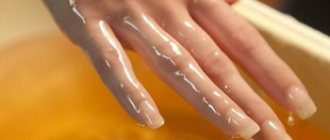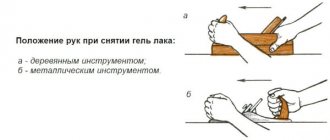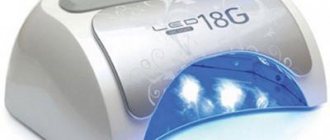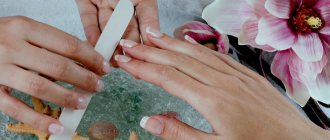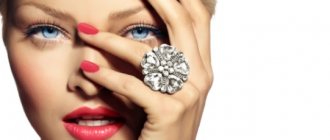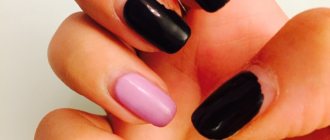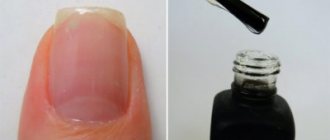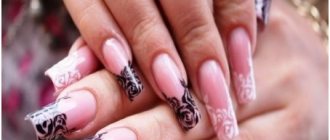and why don't I use it at work?
Natalia went to a beauty salon in the center of Voronezh for three years, where her nails were covered with Shellac. The coating lasted 7 - 10 days, and then began to chip and peel off. Natalya got used to this, and thought that this was how it should be. One day she urgently needed to update the covering, but there was no free window in the salon. On the same day she made an appointment with me for a manicure. I covered Natalya’s nails with gel polish, and we said goodbye.
Three weeks later, Natalya came to me again to update the coverage. She was very surprised that the coating lasted more than two weeks without chipping or peeling. I explained to Natalya that shellac was not suitable for her because she had a thin nail plate. She also explained the differences between gel polish, regular nail polish and shellac.
What is gel polish
Gel polish is a hybrid of varnish and gel, which contains photoinitiators. Under the influence of UV radiation from a special lamp, gel polish turns into a solid polymer. In everyday terms, any polymer is plastic. Obviously, a layer of plastic on natural nails is an unusual phenomenon. However, you should not rush to conclusions about the dangers of gel polish for health.
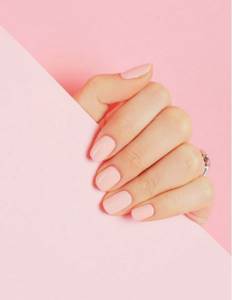
What does it consist of?
There are hundreds of brands offering nail coatings on the shelves of online and offline stores. In most cases, the composition of these products is identical and includes the same components.
The most common ingredients in gel polish include:
- Monomers. Hidden on the label under the combinations of Hydroxypropyl Acrylate and Hydroxyethyl Methacrylate. Monomers are used to harden the coating when exposed to ultraviolet rays;
- Photoinitiator - Hydroxycyclohexyl phenyl ketone. Absorbs ultraviolet rays and starts the polymerization process. Depending on the manufacturer, the amount of photoinitiator varies, which affects the speed of solidification;
- Pigment is a substance that provides a color coating. The composition is marked with an abbreviation, for example CI 8965;
- Solvents. Used to facilitate polymerization that occurs when entering into a chemical bond with monomers;
- Fragrances. To give the product an unobtrusive aroma of fruits or flowers.
The listed components are the basis of the gel polish, which allows it to create a dense coating on the nails with an increased wear time. In addition to the basic components, the composition also contains auxiliary ones - they are the ones that pose a health hazard.
What components of gel polishes and other coatings should be avoided:
- Formaldehyde, Formaldehyde. The most dangerous component that has been discussed from the first day of its addition to the varnish. Formaldehyde is a preservative that promotes long-term storage of the product and prevents the growth of bacteria. The component is allowed for use in nail polishes, but it is prohibited for contact with skin. Formaldehyde often causes allergies to gel polish coating. Manufacturers often hide the presence of formaldehyde in the composition and use non-standard names on the label - Aldehyd mravenc, Bfv, Methanal. Despite the danger, formaldehyde is actively used by manufacturers. Only in the USA a restriction has been introduced allowing the use of no more than 11% of it in the composition;
- Formaldehyde resin. May lead to skin inflammation and dermatitis.
- Toluene, Toluene is a substance from the group of solvents. Also referred to on the label as methylbenzene, methylbenzene, methane. Toluene is a toxic component, the vapors of which in high concentrations cause disorientation. Naturally, varnishes use a minimal amount of the substance, but even this is enough to cause irritation or an allergic reaction. Prohibited for use in all countries within the European Union;
- Dibutyl Phthalate, DBP - a component that protects the coating from cracking. It allows the gel polish to plasticize. Dibutyl phthalate has a negative effect on women's health, hormonal levels and provokes problems with reproductive function. In Europe, the component is prohibited for use in cosmetics;
- Methylisothiazolinone is a preservative that increases the shelf life of the product. Even in small quantities, the component disrupts the functioning of the central nervous system and also negatively affects brain function;
- Camphor, Camphor - used to add gloss. It is a relatively safe component, but with prolonged use it causes allergies. Inhalation of camphor provokes headache and nausea;
- Xylene, Xylene, is another component from the group of solvents that often causes allergic reactions. In addition, xylene may cause side effects such as dizziness, nausea and vomiting;
- Triphenyl phosphate is a plasticizer. It tends to be absorbed through the cuticle and accumulate in the body. Affects the hormonal system. Research by American scientists has proven that triphenyl phosphate has a negative effect on the endocrine system;
- Parabens are sulfate preservatives that mimic estrogen production. Studies have shown that exposure to parabens can trigger the development of breast tumors;
- Ethyl tosylamide. May cause severe allergic reactions, destruction of liver cells;
- Acetone, Acetone - when inhaled, can cause inflammation and sore throat.
Is there any benefit

The benefits of gel polish coating are contained in many aspects:
- It looks luxurious. Conventional varnishes and topcoats do not provide the same shine or matte effect as those containing gel components. Products for “long-lasting” coating are more varied in shades and other effects.
- It lasts 3-4 weeks. Manicure saves time; you can forget about filing or tinting your nails for the entire period. And this, in turn, protects them from additional mechanical stress. Conventional varnishes wear off much earlier; they have to be washed off with solvents and a new layer applied, which is not beneficial.
- You can grow long nails if you had problems with this before. Gel polish involves the use of several layers of products that prevent the plate from breaking off if there is a crack. They are also protected from moisture and household chemicals.
- You can fix a broken nail and correct external defects. This will not work with ordinary varnishes; dents and bumps will still remain noticeable.
In addition, the manicure procedure itself has a positive effect on the nervous system. A woman feels well-groomed, feels that she is devoting time only to herself, and this is also relaxation. And there is an element of creativity in it.
Is it harmful because of the composition: myths and reality
The composition of gel nail polish is not harmful if it contains only the following substances:
- Pigments. They can be made from natural ingredients. But even if their origin is purely chemical, there is no need to be afraid.
- Photoinitiator. This is the component that absorbs light radiation from the lamp. Thanks to it, the coating dries. And it does not have a negative effect on the body.
- Film former. A component that gives the coating hardness, but also maintains elasticity. The film former prevents it from cracking and pulling on growing nails.
- Solvents. This can be ethyl acetate, isopropyl alcohol, butyl acetate and other components that maintain the liquid consistency of the composition.
- Stabilizers. The substances give the gel polish thickness. The group includes trimethylolpropane, the mineral bentonite, and silicon dioxide. They also do not affect health.
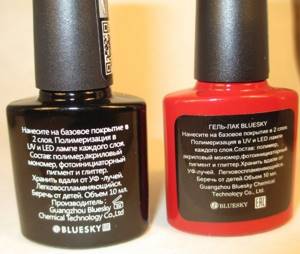
But the opinion about the negative impact of coating on nails and the body as a whole is by no means a myth if the gel polish contains:
- Formaldehyde. This is a known preservative, but it is also a toxic component and tends to accumulate. The substance can reduce immunity, cause allergies, and have a bad effect on the respiratory system. The effect does not weaken as long as formaldehyde is on the nails.
- Toluene. This is also a solvent with a pungent odor, resulting from oil refining, and has a cumulative effect. Its negative effect is mainly on the kidneys, liver and muscle fibers. The substance can also damage your nails.
- Dibutyl phthalate. Another toxic solvent that can interfere with the functioning of the endocrine and reproductive systems.

Fortunately, not all gel polishes contain these components. Newly emerging products do without them, which does not prevent them from being bright and remaining on the nails for a long time.
Why don't I cover my clients' nails with Shellac?
Chips and detachments.
If you have healthy, strong, ideally shaped nails, then using the shellac system your coating will last a maximum of 14 days. Do you have weak, thin or peeling nails? The coating will not stick. Shellac will begin to chip and peel off within 7-10 days - depending on your luck. Everything is exactly this way due to the composition of the varnish itself and the base. SND Shellac base is liquid and acidic. The base is liquid when applied and very firm, but brittle when dry. It is not plastic, so thin, brittle and peeling nails will have chips and detachments.
To better understand, imagine two types of material - paper and board. Paper means thin nails, board means healthy ones. A liquid base was applied to both materials, which dried and hardened. Where will chips appear most quickly? On paper, because the solid material will begin to crack under a fragile base. The same thing happens with Shellac on thin and brittle nails.
Acid base
SND Shellack base is acidic. This means that the base contains components that, when applied, lift the scales of the top layer of the nail plate. Due to this, the base adheres tightly to the nail. No matter what they say, I think it’s harmful, especially for thin and weakened nails. The acid base dries the nail plate. This can cause nails to begin to peel and crumble, especially if the nails were not very strong and healthy to begin with.
Removing the coating by soaking.
According to the technology developed by CND employees, the coating must be removed by soaking. For removal, use special nail pads and removing liquid. The main active component of the remover is acetone, but it is called differently so as not to scare clients and professionals. I have already written about the dangers of this method of removing the coating. But here it won’t work any other way.
Shellac cannot be removed with a machine. Due to the peculiarities of the composition, the material is simply wound onto the cutter. The cutter gets stuck and clogs in the material. In addition, removing shellac with a machine is dangerous - the coating is so thin that there is a risk of sawing through the nail plate. Especially if the master is still unsure of holding the device in his hands. It is often difficult to determine exactly when to remove the foil because different nails may have different base thicknesses. If you haven’t kept your nails in foil enough, then you’ll have to use a pusher and an orange stick to remove the remaining base from the nail. This leads to delamination. If you overexpose your nails under foil, this leads to drying out of the nail plate.
You've probably noticed that after regularly wearing gel polish, your nails weaken, peel, sometimes curl, and white spots and grooves appear. Usually everyone blames gel polish - they say it's harmful, but it's not. This is an acetone containing liquid. It dries out the nail plate, and you can end up with brittle, brittle and peeling nails.
Coated nail repair
Standard situation: got a coated manicure. Three days later, while digging through my purse to find my phone, one of my nails accidentally cracked. There is no point in redoing all your nails - you only need to fix the cracked one. If your nails are covered with shellac, then you will not be able to repair the nail.
Here's what CND representatives advise you to do in such a situation: It all depends on the condition of the nails, but still, such nails are best repaired with acrylic or gel. It's more reliable. It is important to understand that CND Shellac is designed to strengthen well-shaped natural nails. Acrylic and gel cope perfectly with all problems (flat nails, springboard-shaped, broken, etc.).
If a nail covered with Shellac is cracked, it cannot be “fixed” - all ten fingers will have to be redone.
No alignment of the nail plate.
Everyone loves beautiful nails with perfect highlights. Highlights are obtained when the nail has an ideal shape. But the nail does not always have the correct architecture. There are flat, trapezoidal, with tubercles and irregularities, and as many as you like.
To hide these irregularities and give your nails an ideal shape, leveling the nail plate comes to the rescue.
Here are two photos - on some nails the nail plate was aligned, but on others not.

Can you guess which nails are covered with shellac?
The nail plate is leveled with a thick base so that it hides all the irregularities and flaws in the natural shape of the nail. The shellac base is liquid, it spreads over the nail in a thin layer and follows all its irregularities. In shellac, the base serves only to adhere the material to the nail. For full-fledged gel polishes, the base, in addition to adhesion, also forms the correct shape of the nail.
Often counterfeited
Original products are expensive, due to the fact that they are produced and delivered from the USA. That's why Shellac is being counterfeited. Counterfeits are stamped in China, where they are much cheaper. There is no problem buying original products on the official website, or from official representatives, the only problem is the price. Some beauty salon owners buy fake Shellac on Aliexpress. If you paint your nails with this substance, you can easily get a chemical burn or an allergic reaction.
Thickens quickly.
Shellac thickens in open air. This drawback causes more inconvenience for craftsmen than for clients. The master paints the client’s nails, and the varnish in the bottle slowly thickens. The material thickens under the influence of UV rays in a special lamp. When the master opens the bottle, the material is exposed to sunlight, which carries those same UV rays. It often happens that, having used only half the volume of shellac, it becomes impossible to use it further. The material thickened and became unsuitable for work.
These were the shortcomings of shellac, but it deserved worldwide popularity and fame for a reason.
Contraindications to shellac
The application has a number of contraindications; people who have at least one of the above problems should refuse manicure:
- weakened, brittle, peeling nail plates;
- nail diseases (fungal and non-fungal);
- allergies, individual intolerance to one of the components of the nail polish or nail polish remover;
- thin sensitive cuticle;
- skin diseases (eczema, psoriasis, etc.);
- medical nail extension;
- white spots on the plates, indicating a lack of vitamins and body malfunctions;
- immediately after treatment of fungal diseases, the infection may reappear
Other groups of people can get a manicure without fear, sometimes giving their nails a break from constantly wearing the coating.
Consequences due to drying
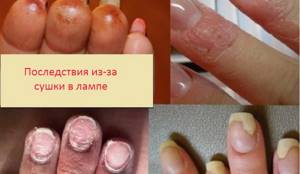
Negative consequences from a professional manicure may arise due to the use of a lamp to dry the coating:
- The appearance of problems such as thinning of the plates, increased fragility, and dehydration of the skin. This is caused by overdrying of tissues and evaporation of nutrients from them. Nails peel or begin to crumble. And peeling and hyperpigmentation may occur on the skin.
- Ultraviolet radiation can damage the epidermis, upper and germ layers of the nails. Burns and soreness in the area of the fingertips may occur. After all, even LED devices that are positioned as absolutely safe contain harmful radiation. And the more powerful the device, the more there is.
- Both previous problems can cause onycholysis. This is the separation of the nail plate from the bed. It occurs as a reaction to constant traumatization by light radiation and overheating of tissues.
- The lamp increases the risk of skin cancer and melanoma. It has been proven that if you are exposed to radiation frequently and without interruption, changes occur in tissues at the cellular level.
However, some scientists refute the last statement. And they say that even if you renew the coating weekly, a high-quality lamp will not harm your nails and skin.
Negative consequences and harm of gel polish from continuous and constant wearing
Even simple nail polish is not recommended for daily use. It is very easy to guess that constantly wearing a chemical covering has its negative consequences. The reason for this is the limited amount of oxygen that reaches the nail plate. Also, due to prolonged use of shellac, the function of the upper protective layer is impaired. If you don't give your nails a break, you may encounter the following troubles:
- delamination as a result of frequent cutting of the top layer;
- and this will lead to fragility;
- depletion of the nail itself;
- that will express itself through dullness;
- and even yellowing;
- cracks may appear;
- and even possible curvature of the nail plate.
Important: This may also be the reason for the poor quality of the gel polish itself. For this reason, you need to use only high quality products and periodically give your nails a rest.
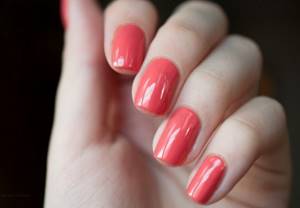
Constantly wearing it can negatively affect the health of your nails.
Does it spoil your nails?
Gel polish spoils your nails if:
- Perform hygienic manicure too carefully. A well-processed cuticle looks attractive, but deep penetration of a cutter or pusher under the skin can cause injury to the matrix. Nails will begin to grow wavy or with permanent cracks. And this is a favorable environment for infections to enter and inflammation to begin. A fungal disease, panaritium, may occur.
- Re-wear the coating, that is, do not go for correction 3 weeks after the manicure. In this case, the load on the regrown edge of the nail increases. As a result, blood circulation in this area is disrupted and the matrix weakens. And onycholysis may occur. And it is especially undesirable to over-stretch for a long length, since the plates can break “into meat”.
- Apply thick layers of polymerizing agents each time. This requires prolonged drying in a lamp, as a result of which the tissue overheats. This is manifested by a burning sensation. And then the nails may become lumpy or, on the contrary, thin out and begin to peel off from the bed.
- Use unsuitable materials. For each type of nail, you need to choose the right base and top coat. Soft ones need a product like strong or other types of strengthening. Applying a rubber base will increase their mobility, that is, increase the risk of breakage and delamination. If the nails are quite strong and hard, they need a softer base. A product marked strong will tighten the plates, which can cause them to crack and break.
- Use low quality products. As a rule, they contain the harmful components mentioned earlier. They dry out the nails and corrode the top layer. As a result, the plates become lumpy, change color, fade, flake and break.
Application Features
To understand whether shellac is damaging your nails, you should carefully consider the application technology. Numerous reviews say that after several sessions the plate becomes thinner than before, brittle, and breaks quickly. Various companies that produce multi-colored compositions are discussed on forums. In addition to reputable American and European manufacturers, samples of which are shown in the photo, more and more craftsmen are trying Chinese options in order to save money.
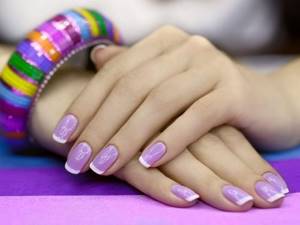
The use of a little-known low-quality material may well lead to allergies, thinning of the plate, and spoils the condition of the cuticle. Therefore, reviews appear about the harmfulness of shellac. Well-known brands guarantee the absence of components and pigments hazardous to health, eliminating problems during use.
The second problem point may be the inexperience of the master. Beginners sometimes file the plate too hard before covering it with the coloring compound. This leads to thinning, fragility and brittleness, which greatly damages it in the future. Good craftsmen easily sand the surface, trying to cause minimal damage.

Is it possible to do this manicure during pregnancy?
The interesting position of a woman becomes the reason for increased sensitivity to most external influences that have at least some impact not only on themselves, but also on the growing baby.
- Of course, pregnant women cannot be refused and, if they wish, the use of shellac is allowed. But this must be done taking into account all, even minor rules, as well as with special caution and literacy.
- Before the procedure itself, it is necessary to apply a high-quality sunscreen to your hands, with an optimal SPF level of at least 30. It will significantly reduce the harmful effects of ultraviolet radiation.
- In no case should there be any toxic components in the composition of the varnishes used. All bottles must have the inscription “5 free”.
- It is better to alternate gel-based varnishes with simple enamels. But, ideally, it would be good to just leave your nails to rest.
- The process itself must be carried out in the fresh air, or in a well-ventilated room. This will significantly reduce the entry of harmful vapors into the body of a pregnant woman.
- In general, in this position you do not need to constantly wear a gel or even a regular coating. Of course, all women at any age and position want to look attractive and well-groomed. But due to hormonal changes, the nail plates already become dull and brittle, and you will also overload them with chemicals.
- Yes, sometimes this will help, on the contrary, to make your nails stronger while wearing the polish. But our advice is to use strengthening products to maintain your nails.

What's special about manicure
Caring for fingernails and toenails has been practiced for a long time. Many people do manicures at home or in specialized establishments. New technologies have turned the procedure into a real art ; you can see paintings on your nails. The special abilities of nail service workers in adjusting and painting nail plates are noted at skill competitions.
Since Ancient Egypt, the treatment of nails with paint and henna began in order to highlight this part as clearly as possible. Closer to our time, they began to form derivatives of the epidermis with special files and apply colored and colorless varnish on top. The horn plates were sharpened in the middle to an acute angle and ground down, but a woman’s manicure with long, healthy nails was considered beautiful. A stylish man could leave one nail on his little finger, and carefully trim and file the rest.
other skills from manicurists . They must understand tools and new materials. Even if the client has an unattractive, brittle, thin cornea, everything can be corrected:
- By extension.
- By applying colorful pollination.
- Gel from different composition of substances.
- Shellac.
Each method has a fundamental difference, so the level of beauty of the coating and the degree of harm to health are different.
How long can you wear without harm?
In any case, there is some harm from gel polish, but much depends on the duration of contact between the nail plate and the coating. You can usually wear a manicure for no longer than two weeks. Under the influence of daylight or natural ultraviolet rays, the coating gradually becomes more dense.
It will be more difficult to remove when visiting the salon. The longer gel polish is left on the nails, the more damage it causes and the greater the risk of injury when removed.

What is more harmful - regular polish or gel polish?
It’s difficult to answer unequivocally. Both products are of synthetic origin. Both can be of high quality or not. The difference is that regular polish has to be removed frequently (sometimes daily), which actually, and not mythically, injures the nails.
At the same time, it can be applied to a treatment base, doing both the beauty of nails and their restoration.
Gel polish dissolves rarely, once every few weeks, and there is always a non-chemical version of “sawdust”, but the bases for it are often ordinary. Strengthening becomes a separate ritual.
However, among gel polish brands there are manufacturers who offer color-matched restorative bases. Thus, gel polishes win with a slight advantage.
See Also Business
A yoga studio in Amsterdam turned into a vegan eco-ice cream shop during quarantine
How to choose a safe gel polish
You can determine the safety and quality of gel polish at first glance at the composition, but for this you will have to:
- Go to the official website of the manufacturer;
- Find information about the composition;
- Make sure that the composition contains hydroxyethyl methacrylate. The component is sometimes replaced by the abbreviation HEMA. It allows for good adhesion of the coating to the nail, while ensuring easy removal;
- Also look for the Free mark on the label - it indicates that the varnish does not contain some toxic substances.
If one of these words is found in the composition, you have a professional and safe product. Please note that the presence of these substances does not guarantee that the varnish will wear well and will not crack or chip. Finding the ideal product will only be possible through trial and error.
Controversial aspects of the harm of shellac

The question of whether shellac or gel polish spoils nails as much as extensions cannot be answered unequivocally. On the one hand, the extension gel and the materials under discussion have almost identical compositions. But on the other hand, when such material is applied in one layer, the plate does not become heavier, as when building up the free edge. Thus, the load on the nails is many times less.
Another feature that makes you wonder whether shellac nails are deteriorating is the tarnishing of its own plate, which is noted by almost all girls who use this coating. A big role here is played by the human factor and the fact that shellac is commercially available, and therefore many girls prefer to apply it themselves. This, combined with the large number of self-taught manicurists who have appeared, leads to the fact that application technology is practically not followed. It’s also good if a protective base was applied under the coating. However, this does not protect the plate if it is applied in too thin a layer, since it is very difficult for a non-professional to find that ideal coating thickness when both the nail is protected and the likelihood of chipping is low.
[yandex2] [google2]
Expert advice
Manicure and pedicure experts share some recommendations that significantly reduce the possible harmful effects of shellac. And not only on the surface of the nails and skin, but also on the entire state of the body.
- It is prohibited to use varnish with a gel base for those who have cracks, fungus or any damage to the nail plate. It is also not recommended to apply gel polish to those whose nails are very flaking.
- You should take a course of medications or vitamins if your nails have a dull and faded appearance.
- It is advisable to enrich the cuticle with nourishing oils, because they contain quite a lot of vitamin components. And this helps nourish the nail itself.
- It is necessary to systematically cover your nails with a colorless nourishing varnish, which can be purchased at any pharmacy or specialty store. Take a break from gel polish at least once every six months.
- To ensure that wonderful and well-groomed nails are always neat and elegant, you should choose only a professional and certified nail technician. If you are practicing or planning to apply the gel yourself, then study each step.
- If you use dark colors, apply a thicker layer of base. This will prevent the plate from staining.
- Do not remove polish with acetone. Prolonged contact has a detrimental effect on nails.
- Be sure to pay due attention to the varnishes themselves. They must be of high quality and not have the harmful additives that we wrote about above.
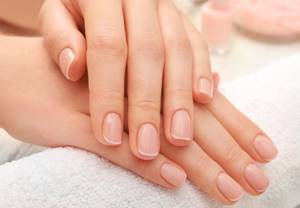
We also offer you a list of harmless gel polishes
- The well-known brand Kodi contains natural oils that have a beneficial effect on our nails. But this company is loved by users for its rubber base, which allows air to pass through and allows them to breathe.
- Ibd varnishes also feature natural ingredients and a complete absence of harmful additives. Moreover, the opaque bottle also protects the contents from ultraviolet rays. Just keep in mind that this all concerns the original, and not the Chinese analogue.
- The Entily brand has already firmly established itself as a durable coating that reliably protects against chips. Moreover, it contains olive and argan oils. And they even additionally nourish the nails. By the way, some varnishes from this company also include natural mica, which more saturates the color and adds a pearlescent touch.
- Irisk varnishes are considered a hypoallergenic product. They do not contain harmful additives. But there are various oils for nourishing the nail, which even help with delamination. By the way, these varnishes also stand out for their quick-drying properties.
- Gels from InGarden can be safely used even for problematic nails that flake or often break. After all, natural resins, silicones and nutritional components will help take care of your nails.
- And it is worth highlighting the Axxium OPI brand, which contains natural substances. But most of all I liked it because there was no need to cut off the top layer of the plate. And this is another plus for strengthening nails.
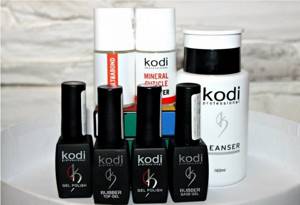
What else is harmful about gel polish: UV lamps and improper cutting
Due to the fact that nails grow quite quickly, it is necessary to adjust the manicure at least 2 times a month. Therefore, we invite you to get to know the “helpers” of gel polish better.
Nail polish removal technique and possible consequences
- Don’t be alarmed, this does not mean that the procedure is contraindicated for everyone or will cause any negative nuances. We are talking specifically about poor-quality or even incorrect cutting and removal of the varnish itself.
- If you diligently remove gel polish (and it doesn’t matter whether this is done with a Fraser or other tools), you can damage the protective film of the nail. Then the manicure will not only be untidy, but will entail all the above-mentioned negative aspects.
- If, when peeling off the varnish, you decide to pull off this piece, then be prepared that with it you will tear off part of the upper scales of your own nail.
- When scraping with sharp objects, you can scratch the top layer, thereby causing peeling of entire nail plates.
- And a few words about preliminary removal of the top layer of the nail. Sometimes incompetent nail technicians clean the nail too much. This also damages the protective layer and spoils the nails themselves.
- Also, special attention concerns the files themselves. We strongly recommend that for natural nails you choose files no more than 240 grit. And then, this is to adjust the form itself. A hard file will cause delamination.
- But for polishing you need to take buffs with a hardness of no higher than 900 grit, or even better – 400.
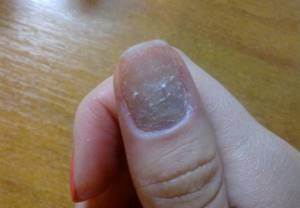
What about the UV lamp?
- Of course, an ultraviolet lamp cannot be called sinless. But it is worth recalling that other technologies also “reward” us with radioactive or ultraviolet radiation. But we use them.
- Moreover, contact with such rays does not last long enough to cause the formation of cancer cells in the body. You wouldn't expose yourself to a lamp every day. And once a month will not bring negative consequences. By the way, LED lamps are less dangerous and dry the varnish in 10-30 seconds. Therefore, they further minimize the harmful effects of ultraviolet radiation.
- But it is still worth considering some recommendations so as not to put yourself at risk from a UV lamp: it is not recommended to dry it for ladies who have a large number of moles on their hands. It is also contraindicated for all those who have at least some wounds or even mosquito bites;
- To use a UV lamp, the master must have the appropriate certificates and certificates with a mandatory note of the characteristics of the equipment;
- It is believed that those lamps that come with the lowest indicator are less dangerous. But then the “baking” time of the varnish increases. Therefore, in the end there is no difference.
Important: To protect your hands from the harmful effects of ultraviolet radiation, wear special or even homemade fabric gloves while drying that only expose your fingertips. And don't forget to use sunscreen. You just need to apply it so as not to touch the nail plate.
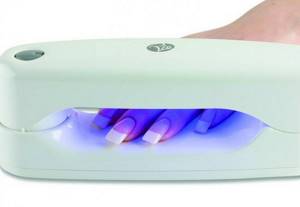
It is advisable to apply a protective cream before drying in a lamp.
Reviews
Olga, 28 years old: “I’ve been wearing gel coating for a very long time; I haven’t taken it off at all for a couple of years. Maybe 3 or even 4 years. But I never noticed any yellowing or dullness. Perhaps this is the result of the right choice of a master and high-quality varnishes. But still, I recommend the use of shellac to absolutely everyone. After all, it’s quite practical, convenient and no less beautiful.”
Valentina, 34 years old: “I had quite a lot of attempts to apply gel polish to my nails, but unfortunately, they all turned out to be disastrous. After a beautiful manicure, which deteriorated after a few days or at most a week, all that was left were yellowed, brittle, thin and dull nails. And how much time, money and effort I spent on their treatment!”
Bogdana, 29 years old: “I constantly use gel polishes. Well, what would we do without them? It is very beautiful, convenient and, very importantly, quite long lasting. After removing the old foundation and before applying a new one, I try to take at least a few days break. Because after probably a year, I began to notice that my nails had turned yellow and became quite dull. Now the situation has improved.”
Alexandra, 24 years old: “I do it for others and for myself. The clients are happy, and I'm not complaining. I use only high quality varnishes, most often from Kodi. All the girls have beautiful nails, and the gel coating strengthens them well. No delamination, fragility or other negative consequences.”
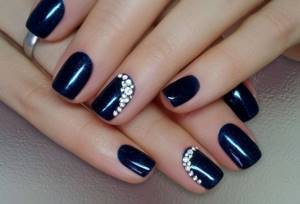
Lyubavin Alexey Vladimirovich: The main problem lies in sawing off the top glossy layer. Inexperienced craftsmen quite often saw through the required amount. As a result, the integrity of the nail plate is destroyed and becomes susceptible to various types of bacteria and infections. Which is fraught with inflammation and infection. And add to everything drying chemicals that deprive the nails of normal breathing, and ultraviolet rays.”
As you can see, there is harm from gel polish and this is an indisputable fact. But the most important thing is to follow all recommendations for applying such a product. And don’t forget to take breaks to saturate your nails with vitamins and strengthening elements. Gel polish will help make your hands well-groomed and neat, but a manicure will only look like this on healthy nails.
Sources
- https://journal.podrygka.ru/byuti-mif-vreden-li-gel-lak-dlya-nogtej/
- https://nails-mag.ru/zdorove/gel-lak-vred/
- https://gel-lak.online/vreden-li-gel-lak-dlya-nogtej/
- https://mimiledi.ru/krasota/manikyur/vreden-li-gel-lak-dlya-nogtey.html
- https://heaclub.ru/vreden-li-gel-lak-dlya-nogtej-dostoinstva-i-nedostatki-produkta-chem-vreden-gel-lak-dlya-zdorovya-organizma-i-samih-nogtej-sostav- i-protivopokazaniya-chem-eshhe-vreden-gel-lak-nepravilnyj-spil-i
- https://poleznii-site.ru/zdorove/polza-i-vred-manikyura-gel-laka-dlya-zdorovya-cheloveka.html
- https://asiateka.ru/vredit-li-sushka-dlya-laka-nogtyam/
[collapse]
Is there any harm from gel polish: advantages and disadvantages of the product
Gel polish is an excellent solution for modern ladies, regardless of age category. After all, not every day there is time to take care of your nails. And a trip to the master guarantees a wonderful and well-groomed manicure for quite a long period.
Let's start with the privileges of gel polish
- Of course, this is great durability. Especially if you also take the varnish of the previous generation for comparison. After all, it was scary to even wash dishes with it, because water could cause peeling. The gel coating can stay on the nails for about three weeks. Yes, the correct application and quality of materials play a role, but that’s another conversation.
- Strengthens the nails themselves, although this aspect also includes other nuances, which we will talk about later. But, on average, a durable layer of varnish also protects the nails themselves from creases. This is especially true for girls with weak and thin nails. This gives them the opportunity to show off a long manicure without resorting to extensions.
- Moreover, gel polish can easily even “fix” a broken nail. To do this, you just need to cover the broken area with a strip from a tea bag. Glue it onto the base and try to give it a natural shape. And then apply the base to the entire nail and subsequent layers in the proper order.
- It is also worth highlighting the first base layer, which also helps to eliminate other unevenness or deformations of the natural nail. It often happens that due to a lack of vitamins, the nail plate turns out in waves - gel polish will hide this nuance. But keep in mind that you still need to take your vitamins!
- The appearance is preserved for a long time without chipping or even loss of shine. Your hands will be well-groomed and presentable.
- The choice of varnishes is huge, and the coating itself comes out brighter, smoother and neater.
- This can be attributed to the absence of a pungent odor, which is typical of conventional varnishes.
Those ladies who have tried a manicure with shellac coating at least once can no longer resist subsequent correction and application of a new design. After all, nothing pleases a real woman more than a fresh manicure.

You can wear gel polish for several weeks without fear for its integrity.
But gel polish also has a downside.
- Applying gel polish requires skill. The quality of the manicure and the health of the nails will depend on this.
- And suitable materials. Although today products can be bought without problems for home use, the high cost is an order of magnitude higher than ordinary varnish. Although, if you add up all the costs for regular polish and multiply by the number of frequent removals and applications, then the gel polish side wins.
- Removal also requires special tools and even skills. And this ties, to some extent, to the master or home equipment. But again let's draw an analogy with a simple varnish. Gel polish will calmly stay with you for 7-14 days, or even more. With the old product this would have been impossible.
- Not suitable for those girls who experience rapid nail growth. After all, after three weeks, all that will remain from a fresh manicure is the name.
- After every 3 months of wearing shellac, you need at least 1-2 weeks of rest. But this is not a minus, but rather an aspect as regards any pigmented nail product.
- Let's return to technology again - any misconduct will cause a damaged manicure, which will need a complete adjustment.
- To some extent, this can be attributed to monotony. No, the choice is now even wider than on the shelves of conventional products. Just wearing it for 2-3 weeks sometimes gets boring. And frequent removal and coating costs your time and money, as well as reducing the health of the nail plate itself.
- By the way, about time. For such a manicure you need more of it, because the precise technology has a number of necessary stages. But you can do it not every 2-3 days, but after 2-3 weeks.
Judging by these criteria, the pros still outweigh any cons. But all this is just the tip of the iceberg.
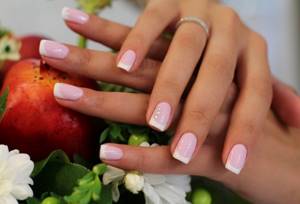
The pros of gel polish still outweigh the cons
